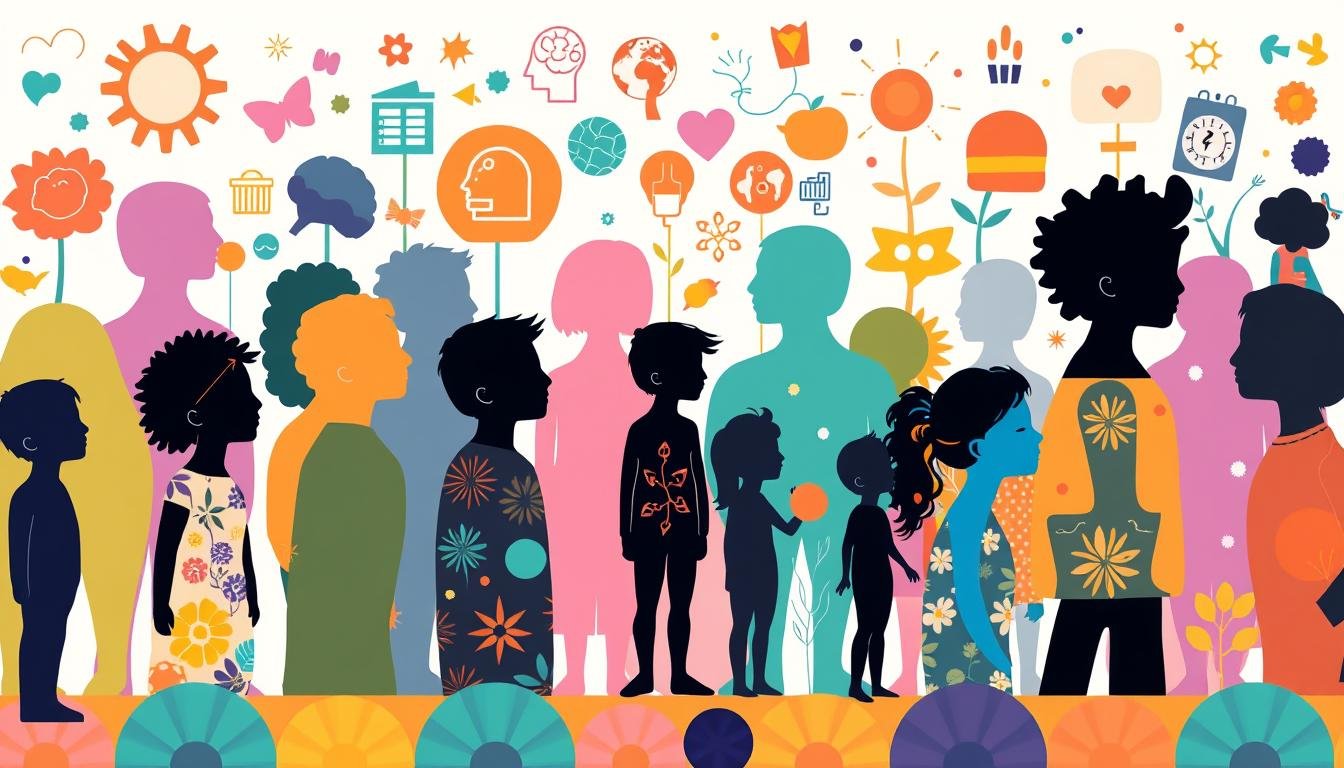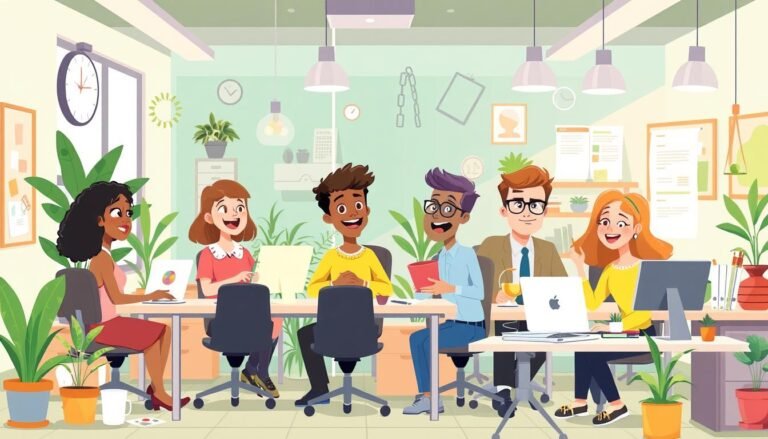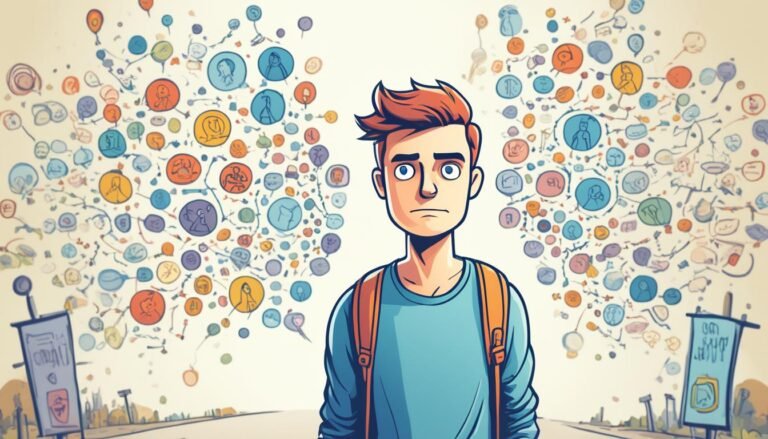Personality and Learning Styles: Unlock Your Potential
Imagine a classroom full of life. In one spot, a student draws detailed diagrams. Nearby, another listens closely to a teacher. Across the room, someone builds a model with their hands. This shows how different we all are in learning.
Our brains and how we learn shape our understanding of the world. Some of us see things better with pictures and charts. Others get it more from listening or doing things hands-on. Knowing these differences can change how we learn.
FLEX College Prep has been leading in education since 2001. They know that teaching should match each student’s unique way of learning. It’s not just about what we learn, but how we learn it.
Discovering your learning style is like finding a superpower. It lets you use your natural talents and beat obstacles. Whether you think in pictures or like to do things with your hands, using your style can make learning fun and better.
Key Takeaways
- Learning styles vary widely among individuals
- Understanding your style can enhance learning effectiveness
- Visual, auditory, and kinesthetic are common learning preferences
- Personality traits influence how we process information
- Tailored teaching approaches can unlock student potential
- Recognizing learning diversity leads to better educational outcomes
Understanding Personality and Learning Styles
Personality and learning styles are key in how we learn. Our unique traits and preferences shape our learning approach. This affects our cognitive abilities and what we prefer to learn.
Defining Personality Traits
Personality traits are the foundation of our character. They influence our behavior, thoughts, and reactions. The Myers-Briggs system, based on Jung’s theory, identifies 16 personality types. It uses four main traits:
- Extroverted vs. Introverted
- Intuition vs. Sensing
- Feeling vs. Thinking
- Judging vs. Perceiving
The Concept of Learning Styles
Learning styles are how we prefer to learn. Different theories categorize these styles. Knowing our learning style can greatly improve our learning experience.
How Personality Influences Learning Preferences
Our personality type affects our learning preferences. For instance, extroverts might enjoy group discussions, while introverts prefer solo study. Sensing types might like practical learning, while intuitive types excel in abstract thinking.
“The learning process is most effective when aligned with individual learning style preferences.”
While tools like Myers-Briggs offer insights, remember our preferences can change. The goal is to stay flexible and adapt our learning approach to reach our full potential.
The Impact of Individual Differences on Learning
How we learn and process information is shaped by our unique traits. Our cognitive abilities, learning preferences, and personal experiences influence our educational path. Research indicates that acknowledging these differences can enhance learning outcomes.
A study of 720 students in a British-Malaysian medical school found a link between specific learning styles and the use of certain strategies. This shows the value of understanding individual learning styles to improve academic performance.
Information style was found to be the most significant factor affecting learning styles. This finding emphasizes the need for educators to tailor their teaching to diverse learning preferences.
Teaching methods should adapt to students’ learning styles for improved academic performance and satisfaction in higher education.
The effect of learning styles on academic achievement is evident. Different styles can result in varying levels of comprehension and achievement. It’s essential to monitor and update students’ learning styles in real time to continuously improve their learning experiences.
| Learning Style | Description | Impact on Learning |
|---|---|---|
| Visual (spatial) | Prefer using pictures, images, and spatial understanding | Enhanced recall through visual aids |
| Aural (auditory-musical) | Learn best through sound and music | Improved retention through audio materials |
| Verbal (linguistic) | Prefer using words, both in speech and writing | Better comprehension through discussions and written tasks |
By recognizing and accommodating individual differences in education, we can increase confidence and engagement. Tailoring teaching methods to meet individual needs can unlock each student’s potential. This fosters a more inclusive learning environment.
Exploring Common Learning Style Models
Learning styles are key in how we take in and understand information. Let’s look at three well-known models that highlight different learning ways.
VAK Model: Visual, Auditory, Kinesthetic
The VAK model focuses on three main learning styles:
- Visual learners like images and graphic organizers
- Auditory learners do well with listening and speaking
- Kinesthetic learners learn best through hands-on experiences
Research finds that over 30% of students are kinesthetic learners. Sadly, many kinesthetic learners struggle in school. This is because traditional teaching methods often don’t meet their needs.
Howard Gardner’s Multiple Intelligences
Gardner’s theory introduces eight different types of intelligence. It shows that people have various strengths and abilities. This challenges the idea of just one type of intelligence.
Kolb’s Experiential Learning Cycle
Kolb’s model stresses the value of hands-on experience in learning. It outlines a four-stage cycle: concrete experience, reflective observation, abstract conceptualization, and active experimentation. This approach lets learners connect with content in a meaningful way.
Knowing these learning style models helps teachers tailor their teaching. Studies show that students taught in their preferred style do better on tests. By using different methods, teachers can make learning more inclusive and effective for everyone.
Personality and Learning Styles: Key Connections
Research has found strong links between personality traits and how we learn. A study at Iran University of Medical Sciences showed interesting results. Students with higher extraversion scores were more likely to choose an accommodating learning style over an assimilating one.
Different fields have their own patterns in personality and learning styles. In automotive technology, most students have a realistic personality type. Psychology students show how personality types affect their learning modes.
Nursing students often have sensing personalities and prefer lectures, discussions, and hands-on work. These findings show how personality influences our learning approach. Extroverts do well in group settings, while introverts prefer studying alone.
Those who are analytical do best with logical methods, and creative people benefit from visual or kinesthetic approaches. This shows how important it is to understand these connections.
“Understanding the connection between personality and learning style can significantly enhance educational outcomes.” – Dr. Emily Clarke, Educational Psychologist
By recognizing these connections, we can tailor learning strategies. Teachers can adjust their methods to meet different cognitive abilities and learning preferences. This personalized approach can increase student engagement and improve learning experiences in various fields.
Identifying Your Unique Learning Style
Discovering your unique learning style can unlock your full potential. By understanding how you best absorb and process information, you can tailor your study methods for maximum effectiveness.
Self-assessment Techniques
Self-assessment is a crucial step in identifying your learning style. Online quizzes and personality tests offer valuable insights into your preferences. These tools can reveal whether you’re a visual, auditory, or kinesthetic learner.
Observing Personal Learning Patterns
Pay attention to your natural learning patterns. Visual learners often have a good memory for faces but may struggle with names. Auditory learners enjoy music and respond well to verbal praise. Kinesthetic learners prefer movement and hands-on activities.
Seeking Professional Guidance
Educators and career counselors can provide professional guidance in identifying your learning style. They can help assess your strengths and weaknesses, guiding you towards suitable learning strategies.
| Learning Style | Characteristics | Preferred Methods |
|---|---|---|
| Visual | Good memory for faces, forgets names | Diagrams, charts, videos |
| Auditory | Enjoys music, responds to verbal praise | Lectures, discussions, audio materials |
| Kinesthetic | Prefers movement, hands-on activities | Demonstrations, open-book exams |
Remember, your learning style may combine elements from different categories. By exploring various self-assessment techniques, observing your personal learning patterns, and seeking professional guidance, you can develop a deeper understanding of your unique learning style and optimize your educational journey.
Adapting Teaching Strategies to Different Learning Styles
Educators face the challenge of catering to diverse learning styles in their classrooms. Jean Piaget noted in 1969 that effective teaching strategies are often the most demanding. To address this, educators can employ adaptive instruction and personalized learning approaches.
Carol Ann Tomlinson offers over 15 strategies for managing diverse classrooms. One effective method is implementing an “anchor activity,” which frees up time for individual student attention. Another strategy involves thoughtful seating arrangements to enhance classroom dynamics.
Incorporating an “expert of the day” system promotes peer-to-peer learning. This approach recognizes that no student is average, making personalized teaching strategies crucial. Learning styles typically fall into four categories: visual, auditory, reading/writing, and kinesthetic.
“Providing choices in learning can increase motivation and reduce challenging behavior for students.”
Differentiated instruction tailors teaching methods, content, and assessments to meet individual needs. Collaboration with colleagues, special education teachers, and instructional coaches is vital for accommodating diverse student needs. Regular reflection and improvement of teaching styles through surveys, observations, and feedback help educators continuously adjust to changing student needs.
| Learning Style | Teaching Strategy |
|---|---|
| Visual | Use diagrams, charts, and visual aids |
| Auditory | Incorporate discussions and oral presentations |
| Reading/Writing | Provide written materials and encourage note-taking |
| Kinesthetic | Include hands-on activities and experiments |
The Role of Emotional Intelligence in Learning
Emotional intelligence is crucial for learning and success. Studies show it boosts student grades and work performance.
Understanding Emotional Intelligence
Emotional intelligence means knowing and controlling your feelings and others’. It includes self-awareness, empathy, and managing emotions. Research shows it has a significant but moderate effect on school success.
Developing Self-Awareness and Empathy
Knowing yourself helps students understand their good and bad points. Empathy lets them connect with others. A study of 234 students found that being kind and cooperative helps in school.
Enhancing Learning Through Emotional Regulation
Learning to control emotions helps stay focused and calm. A company, Westminster Tool, noticed better teamwork after hiring for emotional smarts. They used tools like DISC profiles to solve problems. This led to more learning and growth.
| Personality Trait | Impact on Academic Achievement |
|---|---|
| Conscientiousness | Strong positive relationship |
| Agreeableness | Significant positive impact |
| Emotional Stability | Moderate positive effect |
| Openness to Experience | Slight positive influence |
By improving emotional intelligence, learners can reach their highest potential. They can succeed in school and work.
Neurodiversity and Its Impact on Learning
Neurodiversity celebrates the natural variations in human brain function. It includes conditions like autism, ADHD, and dyslexia. Understanding neurodiversity is key to creating inclusive education environments that cater to diverse cognitive styles.
Research shows that neurodiverse individuals have unique strengths. These include attention to detail, creativity, and logical thinking. For example, autistic people who use their strengths often enjoy a better quality of life. This highlights the importance of strength-based approaches in learning.
Adapting teaching strategies can greatly benefit neurodivergent students. This might involve:
- Providing sensory modifications
- Offering alternatives to public speaking
- Allowing necessary breaks
- Implementing coping strategies for organization and time management
Inclusive education recognizes that all students are capable learners with unique potential. It’s crucial to shift our perspective and view learning differences as variations rather than deficits.
“Neurodiversity is not a weakness, it’s a different way of thinking.”
Support services play a vital role in helping neurodiverse students succeed. For instance, assistive technologies like text-to-speech software can make learning materials more accessible. Extended test times and guided notes are other common accommodations.
| Condition | Prevalence | Key Challenges |
|---|---|---|
| ADHD | ~5% worldwide | Difficulty with verbal instructions, long lectures |
| Autism | 1-1.6% globally | Struggles with noise levels, unexpected changes |
| Dyslexia | Up to 10% | Challenges with reading and writing |
By embracing neurodiversity and providing appropriate support, we can create learning environments where all students can thrive. This approach not only benefits neurodivergent learners but enriches the educational experience for everyone.
Leveraging Technology for Personalized Learning
The digital age has changed education, making it more personal. Technology, especially adaptive learning platforms, is key. These platforms adjust content and pace for each student based on their performance.
They analyze how well students do and create learning paths just for them. This approach has boosted test scores by a whopping 62%.
Adaptive learning platforms
AI is changing education in big ways. Soon, 47% of learning systems will use AI, making learning more engaging and accessible. These platforms quickly figure out what students can do and what they want to learn.
They offer personalized learning paths that fit each student’s needs and learning style.
AI-powered educational tools
AI-driven tutoring systems give students personalized help with great accuracy. Chatbots help with 91% precision, and AI suggests educational resources tailored just for them. This tech lets teachers look at lots of student data.
It helps them understand each student better and create learning plans that really work.
Virtual and augmented reality in education
Virtual reality is bringing new possibilities to education. It creates immersive environments that fit different learning styles. Students can explore complex ideas in 3D, making them easier to understand.
As the AI in education market grows at 36% a year, we’ll see even more tools to make learning personal.
Source Links
- Study Tips For Different Learning Styles
- How Personality Influences Learning Outcomes • Teachers Institute
- Understanding Learning Styles: Unleashing Your Full Learning Potential – Eduolog.com
- Learning Styles of the 16 Personality Types
- 2.5 Personality Types and Learning – College Success | OpenStax
- Exploring the Impact of Individual Differences on Learning Styles and Academic Achievement
- TX_1~ABS:AT/TX_2~ABS:AT
- Microsoft Word – FINALTHS.DOC
- Learning Styles
- Karen Hood’s Paper
- The relationship between personality traits and learning styles in medical education students at Iran University of Medical Sciences: A cross-sectional study
- The Relationship Between Personality Type and Learning Style: A Study of Automotive Technology Students
- Characteristics of Learning Styles
- Discover Your Unique Learning Style with These 7 Tips – Sherwood High
- How to adapt teaching methods to diverse learning styles – T4 Education
- What are the best ways to adapt your teaching style for different learners?
- Emotional Intelligence and Personality Traits Based on Academic Performance
- The Impact of Emotional Intelligence, Personality Profiles and Learning Styles on Training and Productivity
- Understanding and Supporting Neurodiversity in the Classroom
- Neurodiversity at work: a biopsychosocial model and the impact on working adults
- Unveiling the impact of conventional classrooms on neurodiverse students
- How AI Is Personalizing Education For Every Student
- The Role of AI in Personalized Learning
- Leveraging Analytics to Personalize Employee Development








